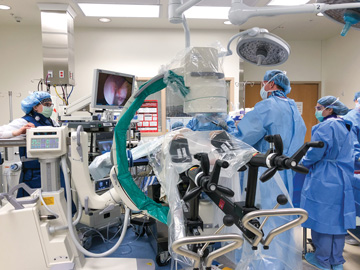• Reduce time and dosages. Dr. Friedman recalled a case that made news in Pittsburgh about a patient who underwent a cardiac catheterization and suffered severe skin burns, which were caused by excessive exposure to radiation.
The fluoro times were over an hour, which flew in the face of the most fundamental principle of radiation safety: ALARA (“As Low As Reasonably Achievable”). Surgeons, radiologists and radiology techs must always aim to use
the minimum amount of radiation necessary to achieve the desired result.
In many cases, you can reduce radiation times simply by paying a little extra attention to the patient’s pre-op images. “Analyzing original radiographs before performing the fluoroscopic examination can reduce the repeat rate for
the time required for the procedure,” says Andriy Kekosh, RT, a radiology technician and radiation safety officer at Boston Out-Patient Surgical Suites in Waltham, Mass.
There are many powerful safety features built into today’s C-arms that are designed to shorten the amount of time patients and staff are exposed to radiation (see “Critical C-arm Safety Features”). “If your facility
uses intermittent fluoroscopy in combination with the image-hold capacity, you can reduce the amount of radiation that’s used,” says Mr. Kekosh. “You can also use pulsed fluoro, single pulse, manual mode, image hold and
time-warning settings.”
Reducing exposure times and dosage requirements often comes down to technique, an area in which the unique experience of radiologists and radiology techs can benefit other specialties. “When we work with C-arms, we’re tapping the
pedal to capture images because we understand the importance of radiation protection,” says Dr. Friedman. “But you’ll often see surgeons with lead feet just put their foot down on it.”
• Maintain safe distancing. The focal distance (also known as source-image distance) is another major component of safe C-arm usage. The exposure you must worry most about involves scatter radiation, not the direct variety —
and you can significantly reduce the risks of scatter through safe distancing practices. “When you increase the distance, you decrease the exposure, typically by a factor of four,” says Dr. Friedman. “It’s sort
of an inverse square relationship.” Generally, he adds, you want to stay further away from the X-ray tube and closer to the image intensifier.
.svg?sfvrsn=be606e78_3)

.svg?sfvrsn=56b2f850_5)